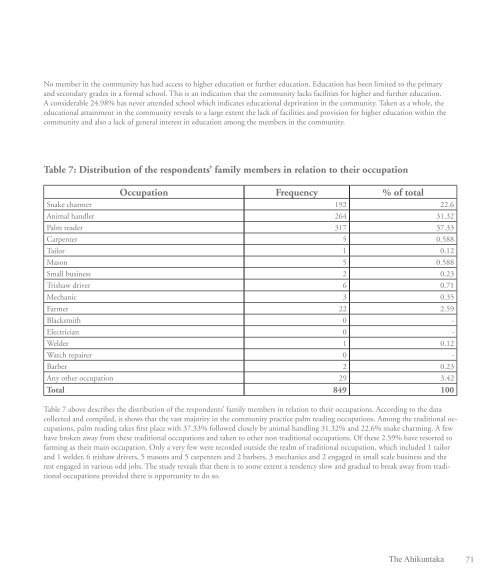The Ahikuntaka
A publication documenting the lives and livelihoods of the Ahikuntaka or gypsy community in Sri Lanka. A collection of vibrant photographs and a baseline survey on the current socio economic status of the Ahikuntaka conducted by the Colombo University complement this timely publication.
A publication documenting the lives and livelihoods of the Ahikuntaka or gypsy community in Sri Lanka. A collection of vibrant photographs and a baseline survey on the current socio economic status of the Ahikuntaka conducted by the Colombo University complement this timely publication.
You also want an ePaper? Increase the reach of your titles
YUMPU automatically turns print PDFs into web optimized ePapers that Google loves.
No member in the community has had access to higher education or further education. Education has been limited to the primary<br />
and secondary grades in a formal school. This is an indication that the community lacks facilities for higher and further education.<br />
A considerable 24.98% has never attended school which indicates educational deprivation in the community. Taken as a whole, the<br />
educational attainment in the community reveals to a large extent the lack of facilities and provision for higher education within the<br />
community and also a lack of general interest in education among the members in the community.<br />
Table 7: Distribution of the respondents’ family members in relation to their occupation<br />
Occupation Frequency % of total<br />
Snake charmer 192 22.6<br />
Animal handler 264 31.32<br />
Palm reader 317 37.33<br />
Carpenter 5 0.588<br />
Tailor 1 0.12<br />
Mason 5 0.588<br />
Small business 2 0.23<br />
Trishaw driver 6 0.71<br />
Mechanic 3 0.35<br />
Farmer 22 2.59<br />
Blacksmith 0 -<br />
Electrician 0 -<br />
Welder 1 0.12<br />
Watch repairer 0 -<br />
Barber 2 0.23<br />
Any other occupation 29 3.42<br />
Total 849 100<br />
Table 7 above describes the distribution of the respondents’ family members in relation to their occupations. According to the data<br />
collected and compiled, it shows that the vast majority in the community practice palm reading occupations. Among the traditional occupations,<br />
palm reading takes first place with 37.33% followed closely by animal handling 31.32% and 22.6% snake charming. A few<br />
have broken away from these traditional occupations and taken to other non traditional occupations. Of these 2.59% have resorted to<br />
farming as their main occupation. Only a very few were recorded outside the realm of traditional occupation, which included 1 tailor<br />
and 1 welder, 6 trishaw drivers, 5 masons and 5 carpenters and 2 barbers, 3 mechanics and 2 engaged in small scale business and the<br />
rest engaged in various odd jobs. <strong>The</strong> study reveals that there is to some extent a tendency slow and gradual to break away from traditional<br />
occupations provided there is opportunity to do so.<br />
<strong>The</strong> <strong>Ahikuntaka</strong><br />
71















